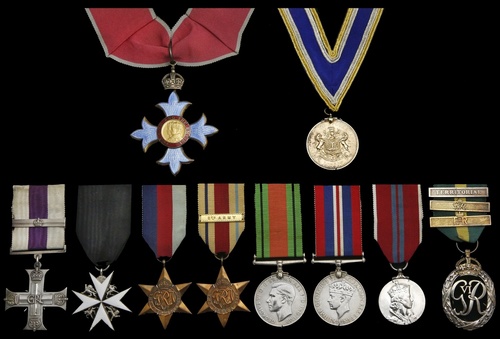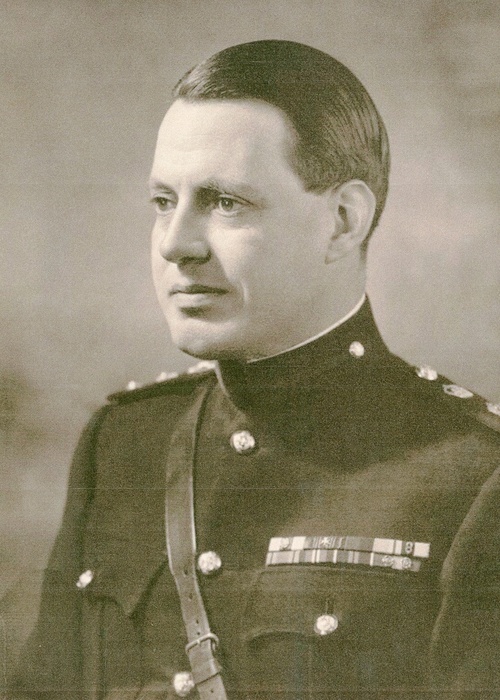Auction: 17003 - Orders, Decorations and Medals
Lot: 703
Sold by Order of a Direct Descendant
An outstanding post-war medical research C.B.E., Second World War North Africa operations M.C. and Bar group of nine awarded to Major J. A. Dudgeon, The Rifle Brigade, who saw much action with the 7th Battalion (The London Rifle Brigade) at El Alamein and beyond
In common with his father, he later rose to prominence as a Professor in medical research and became internationally renowned as a leading specialist on rubella and varicella vaccines
The Most Excellent Order of the British Empire (C.B.E.), Civil Division, Commander's 2nd type neck badge, silver-gilt and enamel; Military Cross, G.VI.R., with Second Award Bar, the reverse of the Cross officially dated '1943' and the reverse of the Bar '1943'; The Order of St. John (O. St. J.), Officer's breast badge, silvered-metal and enamel; 1939-45 Star; Africa Star, clasp, 8th Army; Defence and War Medals 1939-45; Coronation 1953; Efficiency Decoration, G.VI.R., with Second and Third Awards Bars, silver, silver-gilt, the reverse of the Decoration officially dated '1950' and the reverse of the Bars '1950' and '1956', together with Society of Apothecaries, London, Master's neck badge, silver-gilt, by Toye, Kenning & Spencer, hallmarks for Birmingham, 1982, the reverse engraved, 'J. A. Dudgeon, Master, 1985-86', generally good very fine (10)
C.B.E. London Gazette 11 June 1977.
M.C. London Gazette 28 January 1943. The original recommendation states:
'On 25 October 1942, Captain Dudgeon, in order to co-ordinate the anti-tank guns which he commanded, showed complete disregard of danger in moving about, often in an unarmoured vehicle, over a comparatively wide area, under heavy shelling, considerable machine-gun fire and accurate sniping. His success is measured by the fact that that afternoon fourteen enemy tanks were destroyed by his guns, the first time they had been in action.
On the night of 2-3 November, Captain Dudgeon went forward with the leading companies in the attack on Pt. 40, near Tel el Aqqaqir, in order to reconnoitre the position, when won, for his guns. The attack failed and a number of men were killed, or wounded. In spite of heavy machine-gun fire, Captain Dudgeon set about finding the wounded, and on this occasion, alone, was the direct means of saving three men's lives.
He had consistently tended the wounded when his other duties permitted, under considerable and often heavy fire throughout the battles of 25-28 October and 2-3 November. His outstanding determination and disregard for danger, combined with coolness and clear thinking, were very fine examples in very unpleasant circumstances.'
Bar to M.C. London Gazette 1 June 1943. The original recommendation states:
'This Officer commanded the anti-tank company, when the Battalion captured the pass. At first light his company came under intense artillery, mortar and machine-gun fire. Major Dudgeon, with complete disregard to his personal safety and in spite of being wounded in the right foot early in the action, organized his company into a defensive position and in the absence of artillery support, used his guns with great effect. He was continually moving about in the open, encouraging his men and fighting his guns. In the final stages of this action when he was unable to walk and was obviously in great pain, this officer insisted on attending to the wounded (Major Dudgeon was a medical student for four years before the war) before they were evacuated. Throughout the action, Major Dudgeon's courage and leadership were an inspiration to all those with whom he came in contact.'
John Alastair Dudgeon, who took his second forename, was born on 9 November 1916, the son Professor Leonard Stanley Dudgeon, and his wife Nora.
After Repton and Trinity College, Cambridge, he arrived at St. Thomas's Medical School in 1937, but his studies were interrupted by the outbreak of the Second World War. Having joined the 7th Battalion, Rifle Brigade of the Territorial Army in 1936, he decided to put his finals on hold and instead serve as a combatant officer.
Combatant
Embarked for the Middle East, he was appointed to the command of 'C' Company at the battle of El Alamein, and won his first M.C. for knocking out 14 enemy tanks, in addition to bringing his medical skills to use under heavy fire.
After a period of retraining, the 7th Rifle Brigade arrived in the Medenine area and subsequently, after the indecisive assault on the Matmara Hills, joined the New Zealand Corps now opposite El Hammah, and outflanking the enemy. Dudgeon's unit attempted to 'bounce' the Wadi Akarit position, but the attack proved abortive and he was severely wounded. According to Robin Hastings, author of An Undergraduate's War, it 'was one of the few occasions when a single battalion could influence the course of a campaign.'
Dudgeon was invalided home and was awarded a Bar to his M.C.
On leaving hospital, he took his finals and transferred to the Royal Army Medical Corps. He subsequently participated in the top-secret Operation "Tyburn", namely the crash production of vaccine against scrub typhus, one of the most serious medical problems in the jungles of South-East Asia.
Professor
With the war over, Dudgeon's commitment to virology in civilian life began with a posting to the Virus Research Laboratory at Entebbe in Uganda, but in 1949 he, and his new wife, Patricia, returned to St. Thomas's where he became Assistant Pathologist. A year later, he was appointed Assistant Pathologist and Honorary Consultant Virologist to the Hospital for Sick Children, Great Ormond Street, where he served on the Board of Governors from 1962 to 1981. He then spent four years as Director of Virus Research at the Glaxo Laboratories and returned to Great Ormond Street as Consultant Microbiologist.
It was about this time that he began to make his most important contributions to the development of the rubella vaccine. Rubella, more commonly known today as German measles, is a viral infection, now rare in the United Kingdom, which produces rashes, swollen glands and flu-like symptoms such as coughs, a runny nose and aching or painful joints. It becomes a serious concern when women catch the virus during the first twenty weeks of pregnancy; birth defects such as brain damage, heart abnormalities, deafness and cataracts, caused by the rubella virus are known as congenital rubella syndrome (CRS).
During the early field trials of the vaccine, it was necessary to select young women unlikely to be in the earliest stages of pregnancy; Dudgeon made the ingenious suggestion of asking for the co-operation of nuns, and they proved to be 'most collaborative in the research project which was designed to prevent congenital abnormality resulting from maternal German measles.' This highly original idea to conduct preliminary trials in closed religious communities required the permission of the Archbishop of Canterbury, Dr. Ramsay, and the Archbishop of Westminster, Cardinal Heenan. With their support, Dudgeon was able to show that the vaccine virus did not pass from person to person, was safe, and that immunity lasted for many years: it laid the foundations for the routine use of vaccine and what we understand today as the MMR vaccine.
In the early 1960s he began to design the programme of immunisations for children and travellers. At the Institute of Child Health, his programme covered infective gastroenteritis, encephalitis in childhood, and intrauterine infections, with special reference to congenital rubella and cytomegalovirus infections. He was awarded the Harding Medal and the Bissett Hawkins Medal. Dudgeon's remarkable work attracted many young research workers to his Department from Australasia, Europe and the U.S.A., and he enjoyed a Research Fellowship at the Children's Hospital of Philadelphia.
As his career reached its latter stages, he began to take on a more administrative role; he was advisor to the Ministry of Health and a member of the Committee on Safety of Medicines. He was also a consultant advisor on infectious diseases to the World Health Organisation. Appointed C.B.E. in 1977, Dudgeon became Deputy Lieutenant of Greater London in the following year; he had earlier been appointed Officer of St. John (O. St. J.) in 1958. Following his retirement in 1982, he kept himself busy as a member of the Council of the British Heart Foundation and as Chairman of its Research Funds Committee. He was also appointed Fellow of the Royal Society of Apothecaries in 1986.
According to his obituary notice in The Times on 16 October 1989, Dudgeon was 'known for being clear headed, far-seeing and industrious, qualities which were matched by his courteous and kindly manner.' And according to his 1985 entry in Who's Who, aside from his vast achievements in Microbiology, the Professor also enjoyed sailing at the Aldeburgh Yacht Club. In his address given at Dudgeon's funeral, the Reverend Canon David Hutchinson, the Vicar of Aldeburgh, alluded to this interest:
'Alastair's hobby was sailing; and no doubt, with some of his family as crew, battled together against the elements, using the tide and wind for their advantage. This spirit is seen in his battle against ignorance and disease.'
Sold with a quantity of original documentation and photographs, comprising:
(i)
Thesis, University of Cambridge; 'A thesis for the degree of M.D., Cambridge, Epidemic Influenza due to the B virus', dated 1 April 1947; together with a photocopied Thesis: Immunization in Times Ancient and Modern. J. A. Dudgeon, M.D., F.R.C.P., Dean and Professor of Microbiology, The Hospital for Sick Children.
(ii)
A selection of wartime photographs including portrait and group shots (approximately 20), together with letters to his wife, regarding life in North Africa.
(iii)
An album of letters and biographical details, including obituary photocopies from The Times, The Daily Telegraph, The Independent, the British Medical Journal, the Lancet, and the Great Ormond Street Roundabout.
(iv)
Memorandum on Armorial Bearings, written by Professor J. A. Dudgeon, dated 21 April 1986; relating to the arms applicable for a stained-glass window memorial, together with corresponding colour photographs (3) of the memorial panel.
Please see Lot 703 for his father's awards and Lot 638 for his miniature dress medals.
Subject to 20% VAT on Buyer’s Premium. For more information please view Terms and Conditions for Buyers.
Sold for
£4,000







